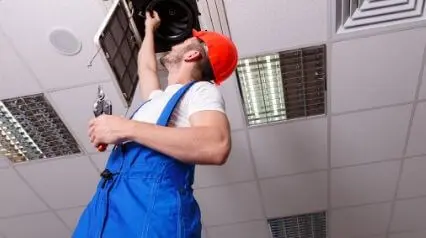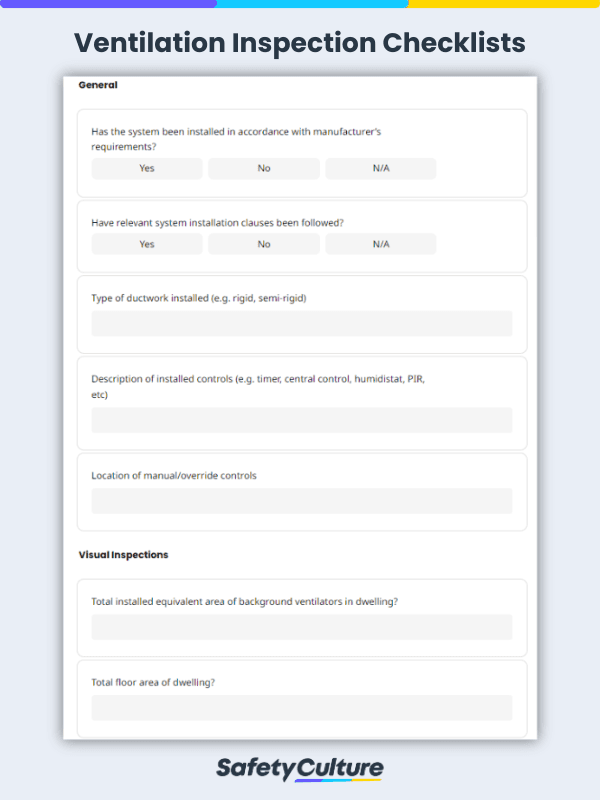What is a Ventilation Inspection Checklist?
A ventilation checklist is a tool used in gathering information on the distributions of airflow, pressure and air quality on ventilation systems. It helps in identifying non-compliance with ventilation requirements and preventing airtightness of the property that can lead to health risk issues, suffocation, and even fatality.
Ventilation Inspection and its Importance
OSHA states that ventilation is one of the most important engineering controls available to the industrial hygienist for improving or maintaining the quality of the air in the occupational work environment. Maintaining good ventilation systems helps:
(a) prevent the spreading and transmitting of airborne diseases such as those causing tuberculosis and legionellosis to other workers;
(b) avert excessive energy consumption;
(c) control the temperature and humidity of the workplace, and
(d) manage toxicity contaminants.
Common Industries That Need Proper Ventilation Systems
Proper ventilation systems depend on the vicinity, purpose of use, characteristics, and area of the property to bring in adequate fresh air by natural or mechanical means. Below are some industries that require proper ventilation systems:
Construction
Welding is a hazardous activity performed especially in confined spaces. Maintaining within safe limits and having a local exhaust ventilation system is important to ensure that welding dust, fumes, and harmful gases are removed from every worker’s breathing zone. Lack of ventilation systems can lead to asphyxiation, suffocation and severe health issues such as asthma, respiratory cancer, and impaired speech and movement.
Office/ Property
The United States Environmental Protection Agency (EPA) reported that 90% of people spend most of their time indoors, like in an office environment, and sometimes have higher levels of exposure to pollutants than staying outside. This makes it significant for employers to give indoor air quality and ventilation higher priority as restricted airflows and poor conditions can lead to occupational asthma, fatigue, allergies, and other respiratory illnesses.
Manufacturing
Adequate ventilation system is a basic operational requirement especially for food manufacturing businesses. It helps ensure workers’ comfort and food safety while controlling temperature, humidity, and indoor air quality. Overlooked ventilation systems can cause the likelihood of food contamination, foodborne illnesses, and pest infestation.
Healthcare
Hospital ventilation systems are considered as a critical system in the healthcare industry. It requires highly specific maintenance and testing to sustain good air quality. Ventilation systems ensure the removal and filtration of contaminated air that protects staff, visitors, and vulnerable patients from airborne bacterial infection.
How to Perform a Ventilation Inspection
Proper inspection and maintenance of ventilation systems are necessary to prevent excessive moisture, the formation of molds, and buildup of air pollutants such as allergens, dust, radon, dander, and cleaning chemical fumes. The below guide help inspectors to perform ventilation inspections.
- Schedule your Inspection
Scheduling inspection helps in taking the time to thoroughly assess the ventilation systems and ensure it is operational and in good working condition. Furthermore, performing scheduled inspections prevent unnecessary incidents, injuries, and illnesses. - Ensure the Ventilation Systems Suit your Needs
Ventilation systems are built with different specifications and capacities depending on the setup and standards that you are trying to achieve. It is important to check your ventilation systems if they are optimized for the needs of your business and ensure compliance with regulatory requirements. - Check Air Intake Screens and Ventilation Systems if Operational
Evaluate the airflow from ventilation vents and secure ventilation screens are in good condition. Check for bent, missing, or damaged parts to provide immediate remediation to avoid air pollutants from clogging the filter. - Look for Pest Infestations
Inspect ventilation structures and determine if there are traces of pests to mitigate infestation. Identify the cause and report the areas that need treatment for immediate corrective action. - Use a Ventilation Checklist
A ventilation checklist is used to guide inspectors in identifying defects, damages, or repair needs. It helps to evaluate ventilation systems to determine improvement and optimization needs for the business.



